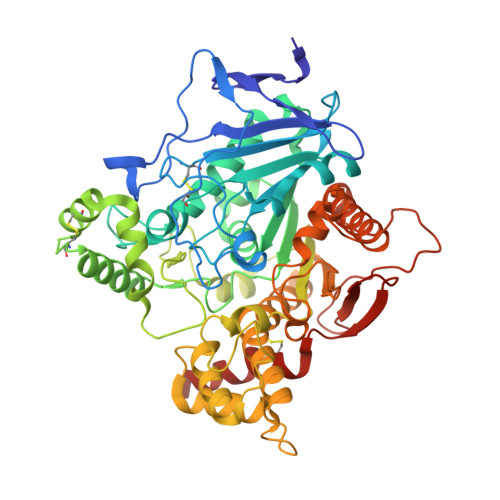Structures of paraoxon-inhibited human acetylcholinesterase reveal perturbations of the acyl loop and the dimer interface.
Franklin, M.C., Rudolph, M.J., Ginter, C., Cassidy, M.S., Cheung, J.(2016) Proteins 84: 1246-1256
- PubMed: 27191504
- DOI: https://doi.org/10.1002/prot.25073
- Primary Citation of Related Structures:
5HF5, 5HF6, 5HF8, 5HF9, 5HFA - PubMed Abstract:
Irreversible inhibition of the essential nervous system enzyme acetylcholinesterase by organophosphate nerve agents and pesticides may quickly lead to death. Oxime reactivators currently used as antidotes are generally less effective against pesticide exposure than nerve agent exposure, and pesticide exposure constitutes the majority of cases of organophosphate poisoning in the world. The current lack of published structural data specific to human acetylcholinesterase organophosphate-inhibited and oxime-bound states hinders development of effective medical treatments. We have solved structures of human acetylcholinesterase in different states in complex with the organophosphate insecticide, paraoxon, and oximes. Reaction with paraoxon results in a highly perturbed acyl loop that causes a narrowing of the gorge in the peripheral site that may impede entry of reactivators. This appears characteristic of acetylcholinesterase inhibition by organophosphate insecticides but not nerve agents. Additional changes seen at the dimer interface are novel and provide further examples of the disruptive effect of paraoxon. Ternary structures of paraoxon-inhibited human acetylcholinesterase in complex with the oximes HI6 and 2-PAM reveals relatively poor positioning for reactivation. This study provides a structural foundation for improved reactivator design for the treatment of organophosphate intoxication. Proteins 2016; 84:1246-1256. © 2016 Wiley Periodicals, Inc.
- Special Projects Group, New York Structural Biology Center, New York, New York, 10027.
Organizational Affiliation:






















